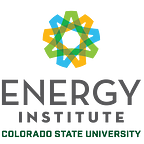NREL: a model for campus as a research apparatus
By Shelby Condit, Media & Communications Intern, Energy Institute
Last week, Michelle Slovensky, NREL Energy Program Manager, spoke at the Powerhouse Energy Campus on how NREL — the National Renewable Energy Laboratory located in Golden, Colo. — uses the CSU campus as a research arm for their work. Slovensky is an expert in smart-green-building design, holds a degree from the Harvard University Graduate School of Design, and has decades of interdisciplinary experience.
NREL’s mission is to advance, “The science and engineering of energy efficiency, sustainable transportation, and renewable power technologies and provides the knowledge to integrate and optimize energy systems.” This mission closely aligns with the CSU Energy Institute’s work, and makes research partnerships between NREL and the campus a natural fit.
In 2010, NREL completed construction of a net-zero energy facility. A net-zero facility is a building where the total amount of energy used by the building on an annual basis is roughly equal to the amount of renewable energy created on the site. After construction of the building, NREL studied the building from a new perspective and sought to authenticate and to publish those results. To achieve this, they formed a team to examine the design of a “new data architecture.” The intelligent campus followed, which is a model for a research apparatus utilizing NREL resources, energy informatics, and scientific discoveries, by way of “multi-directorate experts, united in the goal of enabling collaboration among researchers and operators with high-fidelity data that balances risk,” Slovensky said.
The system uses the entire campus in order to identify how different aspects of these fields appear through the lens of the other. The intelligent campus design seeks to build a bridge between research and operations, in order to efficiently record and analyze data throughout the facility and hone in on energy use. Focusing on in-depth data analytics throughout facility processes allows for a more thorough look at efficiency. According to Slovensky, “You can’t just slap a standard on every building. You have to have a safety standard based on individual locations and labs. By narrowing things down to a more detailed hierarchy, it helps us by being able to use target analytics in determining where energy use can be lowered.”
NREL’s data could provide a basis for energy efficient building architecture, as well as an example for other intelligent-campus-designed research facilities, while the overall real-world applications are seemingly endless.
For further information about NREL or to schedule a tour, visit their website at nrel.gov.
